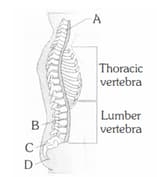HARD
Earn 100
The given figure indicates vertebral column of human (right lateral view). Parts labelled as A, B, C and D respectively represent


(a)Cervical vertebra, Intervertebral disc, Sacrum and Lumbar vertebra
(b)Cervical vertebra, Intervertebral disc, Lumbar vertebra and Coccyx
(c)Cervical vertebra, lntervertebral disc, Sacrum and Coccyx.
(d)Lumbar vertebra, Intervertebral disc, Sacrum and Coccyx
78.57% studentsanswered this correctly
Important Questions on Locomotion and Movement
EASY
HARD
MEDIUM
MEDIUM
Match the following.
| SET-I | SET-II | ||
| (A) | Os penis | (I) | Sesamoid bone |
| (B) | Girdle | (II) | Visceral bone |
| (C) | Patella | (III) | Cartilage bone |
| (D) | Cranium | (IV) | Investing bone |
EASY
EASY
MEDIUM
MEDIUM
Match the following columns and select the correct option.
| Column-I | Column-II | ||
| (a) | Floating Ribs | (i) | Located between second and seventh ribs |
| (b) | Acromion | (ii) | Head of the Humerus |
| (c) | Scapula | (iii) | Clavicle |
| (d) | Glenoid cavity | (iv) | Do not connect with the sternum |
EASY
EASY
EASY
HARD
MEDIUM
EASY
Fill in the blanks with correct options:
EASY
EASY
EASY
MEDIUM
MEDIUM
Represent the union of two sets by Venn diagram for each of the following.
is a prime number between and
is an odd number between and

